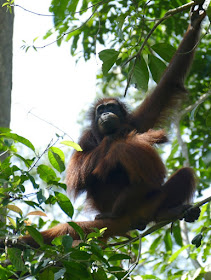In the last posting we talked about orange in animals, focussing on birds. I raised there the problems of precisely defining orange, and I think that becomes even trickier in mammals. For instance by what colours would you define this antelope and tiger?
 |
| Impala Aepyceros melampus, Lake Mburo NP, Uganda |
 |
| Sumatran Tiger Panthera tigris sumatrae, Adelaide Zoo (and how I wish I could tell you I'd photographed it in Sumatra!) |
I think that both could arguably be described as orange (indeed Wikipedia uses a tiger to illustrate its article on orange) though I'd probably think of them as rusty red/chestnut and will deal with this shade thus in a future posting.
An important difference between orange pigment in birds and in most other animals is in the nature of the pigments themselves. For instance while mammals certainly absorb carotenoids from their food and metabolise them, few if any mammals use them for colouration. Instead yellows and oranges and rusty tones in mammals (including in red-haired humans) are due to a class of melanins (normally thought of as brown or black) called pheomelanins. These can be synthesised in the body, unlike carotenoids.
When I started looking into it, I discovered that most of the mammals I'd call orange - as opposed to chestnut etc - are primates. The most obvious of these are Orangutans. (And of course the name comes from Malay, and has nothing to do with 'orange'.)
 |
| Bornean Orangutan Pongo pygmaeus, with baby, Sepilok, Sabah. |
 |
| Venezuelan Red Howler Monkeys Alouatta seniculus, Manu NP, Peruvian Amazonia. Despite the name, this is the common red howler of the western Amazon; three species are now recognised. |
 |
| Red Leaf Monkey Presbytis rubicunda, Gomantong Caves, Sabah. This beautiful monkey is restricted to Borneo and nearby islands. |
Primates don't have the orange mammal certification entirely to themselves though.
 |
| Northern Amazon Red Squirrel Sciurus igniventris, Yasuní NP, Ecuador. |
In other vertebrates the story is different again. The class of chemicals known as pterins was first described from (orange) butterfly wings, but they have since been discovered in a range of other groups, including reptiles and amphibians (and other invertebrate groups, but we'll visit them next time). Like melanins, but unlike carotenoids, they can be synthesised by animals.
 |
| Basking Land Iguana Conolophus subcristatus, North Seymour, Galápagos. Like the frogs, this somnolent fellow almost certainly employs pterins to brighten himself up. |
And there we'll leave if for today, returning soon (when I'll be preparing it 'live') to look at orange invertebrates.
BACK ON THURSDAY 24 SEPTEMBER



For the first two animals I would switch to French if at all possible and describe them as fauve, a word that means basically 'wild animal colour'. It applies especially to big cats. The best English translation is 'tawny' although it is often translated as 'fawn', which I think is misleading.
ReplyDeleteThanks Susan - that really does raise all sorts of fascinating questions about how different cultures see colour. (I'm pretty I read somewhere that in Russian what we'd call dark and light blue are regarded as different colours?) Your fauve fits the bill much more adequately than any English word I can find, though tawny is good!
ReplyDelete